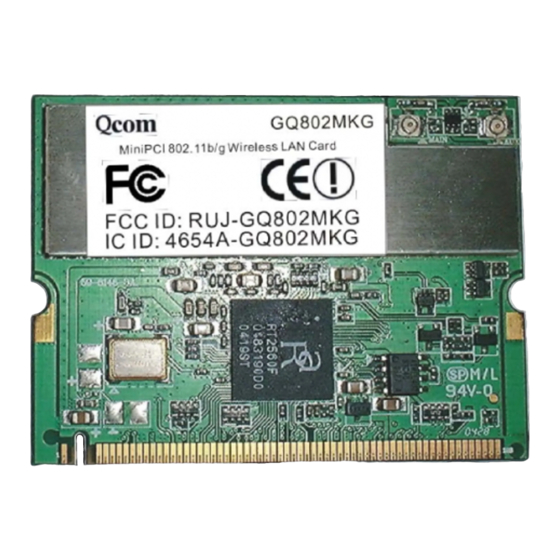
Advertisement
Quick Links
Advertisement

Summary of Contents for Qcom GQ802MKG
- Page 1 GQ802MKG User’s Manual...
- Page 2 Driver Installation 1 . Go to the directory where the Wireless Adapter Installation stored, then double-click Setup.exe to begin the installation. 3. RALINK Wireless Network Card Setup will install the driver on your system, click Next to continue.
- Page 3 4. Select the Country Channel, and click Next to continue.
- Page 4 5. The installation is now complete. Please click Finish. 6. When you complete the installation, the utility icon will appear on the system tray. You could double-click it to configure wireless network settings...
- Page 5 Uninstalling the Wireless LAN Card 1. For uninstalling the Wireless LAN Card, please go to: Start -> Programs -> Ralink -> RT2500 under Windows environment. Then click Uninstall. 2. Select Remove to uninstall the Wireless LAN Card.
- Page 6 3. The Confirm Uninstall screen will display, click OK to confirm. 4. Wait for removing the utility. 5. After completing the uninstallation, click OK.
- Page 7 Configuring the Wireless LAN Card Double-click the utility icon in your system tray to begin the utility configuration. Connecting to an existing network Select Site Survey Tab, all available Access Points would be listed. Click on the desired Access Point, and click Connect to connect.
- Page 8 Configuration Profile The Profile Tab allows you to set values for all parameters by selecting a previously defined profile. To create a profile, click Add, type a profile name and set the corresponding parameters. If one of the profiles is no longer used, you may remove it by clicking the Delete button.
- Page 9 Status The field shows the association status to available Access Point with SSID<->MAC address of the Access Point. Current Channel Shows the channel on which the connection is made. Current Tx Rate Shows the highest transmit rate of the current association. Throughput (Kbits/sec) This displays the instantaneous wireless Receive and Transmit throughput in Kbits per second.
- Page 10 Add to Profile You may select an Access Point, and click Add to Profile to include it to Profile List. Under Add Profile screen / System Configuration Tab, you may set Power Saving Mode, Network Type, Transmit Power, RTS Threshold, and Fragment Threshold. Under Add Profile screen / Authentication vs.
- Page 11 After fishing the Add Profile, Check Profile Tab, you may find the new added profile in Profile List.
- Page 12 Statistics The Statistics Tab provides information about the Transmit and Receive frames. Advance The Configuration Utility also offers the advanced configuration for user to set the Wireless Adapter under certain network environment. These advanced options include Wireless Mode, Adhoc Mode, TX Burst, B/G Protection, Tx Rate, and Turn Off RF.
- Page 13 About About Tab shows the product version including the detail of Configuration Utility Version, Driver Version, EEPROM Version, and NIC MAC Address.
-
Page 14: Important Note
Federal Communication Commission Interference Statement This equipment has been tested and found to comply with the limits for a Class B digital device, pursuant to Part 15 of the FCC Rules. These limits are designed to provide reasonable protection against harmful interference in a residential installation. - Page 15 This transmitter module is authorized only for use in device where the antenna may be installed such that 20 cm may be maintained between the antenna and users (for example: Notebook). The final end product must be labeled in a visible area with the following: “Contains TX FCC ID:RUJ-GQ802MKG”.
- Page 16 Manual Information That Must be Included The OEM integrator has to be aware not to provide information to the end user regarding how to install or remove this RF module in the users manual of the end product which integrate this module. The end users manual for OEM integrators must include the following information in a prominent location “...
- Page 17 Canada-Industry Canada(IC) Operation is subject to the following two conditions: 1) this device may not cause interference and 2) this device must accept any interference, including interference that may cause undesired operation of the device. This device has been designed to operate with an antenna having a maximum gain of 1.35dBi.
Need help?
Do you have a question about the GQ802MKG and is the answer not in the manual?
Questions and answers